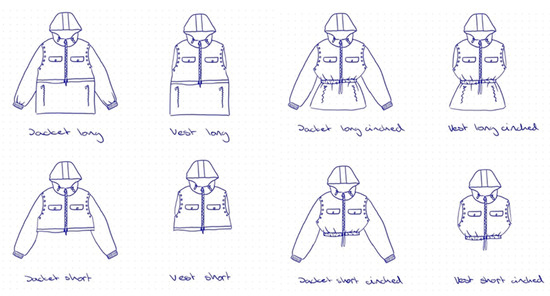You're using an outdated browser. Please upgrade to a modern browser for the best experience.
Please note this is a comparison between Version 1 by Lilia Sabantina and Version 2 by Peter Tang.
Due to the almost linear textile chain, large amounts of non-renewable resources are consumed to produce cheap clothes that are only worn a few times. Particularly problematic are the fiber waste and the enormous water consumption of the textile industry.
- sustainability
- textile waste
- recycling
- textile manufacturing
- renewable sources
- zero-waste
- transformable design
1. Introduction
The McKinsey study predicts large-scale fiber-to-fiber recycling by 2030, creating a sustainable circular economy in Europe [1]. The European Commission envisions durable, repairable, recyclable textile products made from recycled fibers, free from hazardous substances, and produced with respect for social rights by 2030 [2]. The garment manufacturing process produces a lot of waste, which includes not only fabric waste but also residual fibers and yarns, dyes, and chemicals used in the dyeing process of fibers and textile surfaces, which pollute the environment [3]. Waste, in particular, is a major problem in the textile industry. Each European consumes almost 30 kg of clothing per year, of which 11 kg is thrown away.
2. Fibers from Waste
There are ample opportunities to recover fibers from agricultural, food, and cutting wastes in the textile production and recycling processes, but these methods often receive insufficient attention. For instance, in paper production, wood is commonly used to obtain cellulose, while the discarded tree bark is typically incinerated or discarded. Similarly, in pineapple or banana harvesting, the leaves and fruit contents contain valuable fibers that could be utilized as a sustainable alternative for pulp recovery, but they are often overlooked [4][6]. Despite their suitability for casein fibers, valuable by-products generated during milk production are often discarded and wasted. These by-products could be utilized to create sustainable casein fibers, thereby reducing waste and maximizing resource efficiency in the milk production process [5][7]. The casein protein utilized in creating the fabric is sourced from discarded milk that would otherwise go to waste, making it an eco-friendly option. Cellulosic fibers from sources like bast or stem fibers in the inner bark of dicotyledonous plants, leaf fibers in monocotyledonous plants, and fibers from seeds and fruits can be used for fiber production. Bio-based fibers like ramie, flax, hemp, jute, sisal, and coir are commonly used for technical purposes due to their rough texture and strong mechanical properties. These fibers can be obtained through isolation processes involving bacteria, fungi, as well as chemical and mechanical methods. Chitin, found in the cell wall of many fungi, can be extracted from fungal biomass through alkali treatment [6][8]. This presents a sustainable and eco-friendly resource for the production of textile fabrics with potential applications in sustainability-driven industries.3. Sustainable Finishing
Chitin and chitosan, which can be obtained from tons of shell waste from the processing of crustaceans and fungi, are versatile materials used for the surface modification of textiles [7][9]. Their incorporation into textile finishing processes can improve properties such as dyeability and color strength [8][10]. In addition, chitosan applications in textile finishing can impart antimicrobial, anti-odor, anticoagulant, antistatic, and crease-resistant finishes, providing further functional benefits to textiles. These multifunctional properties make chitin and chitosan valuable resources for textile innovation and sustainability [9][11]. Other sustainable alternatives to petroleum-based wax systems for textile finishing include natural animal waxes such as beeswax and vegetable waxes (e.g., palm wax, soy wax, castor wax, sunflower wax). The bio-based waxes form a protective layer that repels water and prevents the sun’s UV rays from drying out the plant [10][12].4. Multifunctional Design
Design plays a significant role in the environmental impact a garment will have throughout its life cycle. The design stage sets the roadmap for the further production of a garment, so it is at this stage that sustainable practices need to be implemented to ensure a more sustainable garment production process. Today’s fashion industry is based on rapid cycles of changing styles, creating a culture where psychological obsolescence becomes the norm. Consumers are under pressure to own the latest trends, so clothes go out of fashion at an increasingly rapid rate [11][13]. Nes and Cramer’s theory suggests that by delaying product replacement, a consumer’s period of use and lifetime is extended. By designing garments with multifunctional and adjustable features, the consumer’s need for the new can be minimized. Designing for longevity means that the product can evolve with the owner, with the adaptability of transformable design increasing the chances of wearing the garment more and for longer [12][14]. Because the garment can be changed to suit different occasions and seasons, the wearer’s needs and desires are met, which in turn leads to greater product satisfaction [13][15]. Ultimately, transformable design actively involves the consumer in the design process, as they are the ones who decide which transformation stage they want to wear the garment in each time they wear it. This strengthens the emotional connection between the wearer and the garment, which directly leads to better care of the garment and, therefore, longer use.5. Modular Transformable Design
The outdoor jacket was designed with the capability to transform itself into different pieces of clothing that showcase different styles and are wearable in different seasons, making this jacket not only wearable all through the year within different weather conditions, but also a fashionable piece that can be styled in a number of different ways. The design of this jacket aims to achieve multiple functional and/or aesthetic transformations achieved by different techniques, as shown in Figure 1.
Figure 1. Sketches showing the eight variations in which the jacket can be worn. (Top row: jacket long, vest long, jacket long cinched, vest long cinched; upper row: jacker short, vest short, jacket short cinched, vest short cinched).
